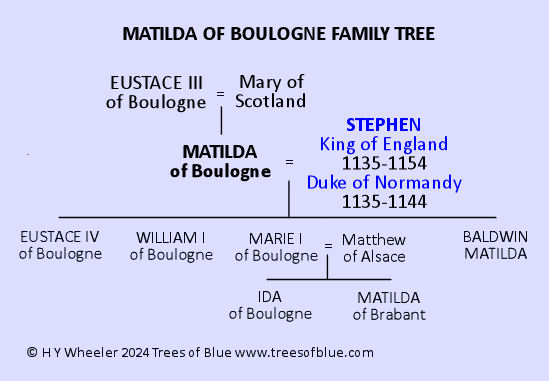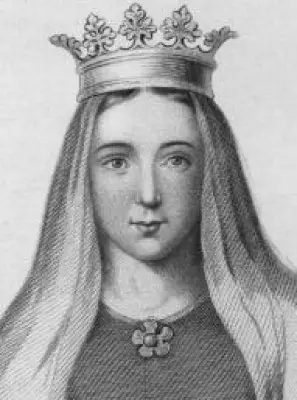Matilda of Boulogne (c. 1105 – 1152) was a member of the House of Flanders by birth and of the House of Blois through her marriage to King Stephen of England.
Contents
Matilda of Boulogne Family Tree Image
Matilda of Boulogne Family Tree in Table Form
Matilda of Boulogne Short Biography
Matilda of Boulogne Family Tree Image showing:
parents, siblings, wife, children and grandchildren

King Stephen Family Tree in Table Form showing:
grandparents, parents, siblings, wife, children and grandchildren
GRANDPARENTS
Paternal Grandfather – Eustace II of Boulogne – (1015 – 1087)
Paternal Grandmother – Ida of Lorraine – (c. 1040 – 1113)
Maternal Grandfather – Malcolm III, King of Scotland – (1031 – 1093)
Maternal Grandmother – Margaret of Wessex – (c.1045 – c.1093)
PARENTS
Father – Eustace III of Boulogne – (1050 – 1125)
Mother – Mary of Scotland – (1082 – 1116)
SIBLINGS
No Siblings
MARRIED
Stephen, King of England – (1092 – 1154)
CHILDREN
Baldwin – (d. c 1135)
Matilda – (d. c 1141)
Eustace IV, Count of Boulogne – (1130 – 1153)
William I, Count of Boulogne – (1135 – 1159)
Marie I, Countess of Boulogne – (1136 – 1182)
GRANDCHILDREN
by Marie I
Ida of Boulogne – (c.1160 – 1216)
Matilda of Brabant – (1170 – 1210)
Matilda of Boulogne Short Biography
Early Life and Marriage
Matilda of Boulogne was born around 1105, the daughter of Eustace III of Boulogne and Mary, daughter of King Malcolm III of Scotland.
Matilda was raised in the court of Boulogne, a strategic county in northern France. In 1125, she married Stephen of Blois, a grandson of William the Conqueror. In the same year as her marriage, Matilda’s father died and she inherited the County of Boulogne which she ruled jointly with Stephen.
The couple had five children: Baldwin who died in 1135, Matilda who died in 1141, Eustace, William and Marie. The latter three would all rule Boulogne.
Queen Consort of England
In 1135, King Henry I of England died. Although Stephen had sworn to support the succession of his cousin, Empress Matilda, he seized the throne for himself. Matilda and her husband Geoffrey of Anjou were understandably angry and contested Stephen’s place on the throne. This resulted in a long period of Civil War known as The Anarchy.
During he conflict, Matilda of Boulogne proved herself a loyal and capable supporter of her husband’s cause. When Stephen was captured at the Battle of Lincoln in 1141, Matilda acted swiftly to rally their forces. She secured the support of Londoners who prevented Matilda from being crowned at Westminster Abbey and forced her to flee to Oxford.
Matilda also managed to secure the capture of Matilda’s half-brother and commander of her armies, the Earl of Gloucester. She was then able to bargain for a prisoner swap which secured the release of Stephen. Nevertheless, the war dragged on.
Patronage and Diplomacy
Matilda was a pious woman deeply invested in religious patronage. She and Stephen founded several religious institutions, including Faversham Abbey in Kent, where they were both later buried.
Her diplomatic skills were instrumental in maintaining alliances during the conflict and managing the loyalties of key nobles.
Later Life and Death
By the early 1150s, the civil war had reached a stalemate. The strain of the conflict and her role in it took a toll on Matilda’s health and she died on May 3, 1152, at Hedingham Castle in Essex. Her death was a blow to Stephen, who outlived her by only three years. Their eldest son, Eustace, predeceased Stephen, paving the way for the eventual succession of Empress Matilda’s son, Henry, as part of the Treaty of Wallingford, signed in 1153.
Published Apr 11 2020 – Updated – Dec 4 2024
Harvard Reference for this page:
Heather Y Wheeler. (2020 – 2025). Matilda of Boulogne 1105 – 1152. Available: https://www.treesofblue.com/matida-of-boulogne-1105-1152. Last accessed April 15th, 2025

